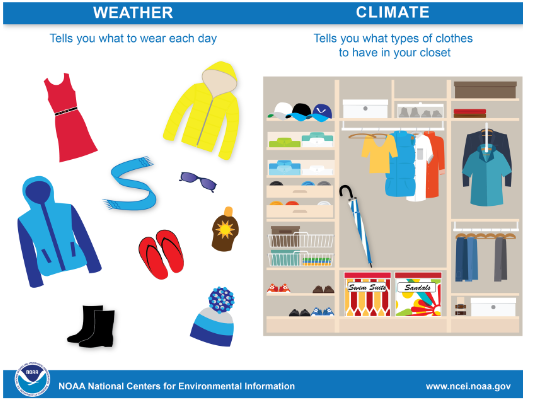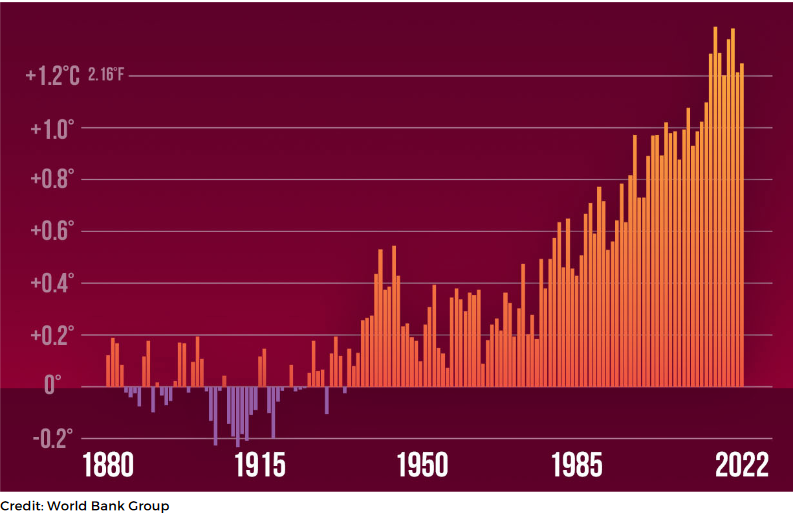According to NASA, the term weather refers to the atmospheric conditions that occur locally over short periods, while climate refers to the long-term regional or global average of temperature, humidity, and rainfall patterns. The main difference is time. The weather is only temporary. The climate, on the other hand, is more than just a few warm or cool days. Climate describes the typical weather conditions in an entire region for a very long time – 30 years or more.
Things That Make Up Our Weather
Weather consists of various phenomena such as sunlight, rain, cloud cover, wind, hail, snow, sleet, floods, blizzards, thunderstorms, heat waves, etc.
Things That make up our Climate
Climate represents the average weather over a vast period and is determined by combining ocean currents and wind patterns.

What is climate change?
Earth has been under scientific observation for a very long time. Scientists have gathered vast amounts of data about the five interactive systems that constitute the earth’s climate system: the lithosphere (earth’s upper surface layer), the atmosphere (earth’s thin layer of gases surrounding it), the hydrosphere (earth’s liquid water in oceans and lakes), the cryosphere (earth’s solid frozen water in ice and snow), and the biosphere (earth’s living organisms). According to the information, scientists have been able to extract for the data, the climate of the Earth is getting warmer. As the atmosphere is heating up, the weather patterns are changing and wet areas become wetter, while dry areas become drier.
Alterations in the Earth’s climate are caused by a combination of natural forces, such as volcanic eruptions and variations in solar intensity, and human activity, predominantly releasing heat-trapping greenhouse gases. Climate change relates to the broader range of changes in the earth’s climate system, such as rising sea levels caused by melting ice sheets and glaciers. This term is usually confused, or replaced with Global Warming but they are two distinct definitions. Climate change refers to shifts in temperatures and weather patterns. So, when we are talking about climate change, we are talking about changes in long-term average daily weather. In most places, weather can change from minute to minute, hour to hour, day to day, and season to season.
A glaring example of climate change is the growing seasons changing. Winters are getting shorter, spring is coming earlier, and fewer days are getting below freezing.Numerous life cycle events, such as flower blooming or the emergence of pollinators, are impacted by these changes in timing. Because different species may react differently to environmental cues, resulting in a misalignment between species that may depend on one another, changes in the timing of these events, such as the spring
thaw or songbird migration, can have serious effects on ecosystems.
Some interesting facts about climate change in the Global Climate Dashboard are listed below.
- Since the start of the satellite era in 1979, the extent of ice covering the Arctic Ocean at the end of summer has shrunk by more than 40 per cent.
- Earth’s temperature has risen by an average of 0.14° Fahrenheit (0.08° Celsius) per decade since 1880, or about 2° F in total.
- 2022 was the sixth-warmest year on record based on NOAA’s (National Oceanic and Atmospheric Administration) temperature data.
- The rate of global sea level rise is accelerating; it has more than doubled from 0.06 inches (1.4 millimetres) per year throughout most of the twentieth century to 0.14 inches (3.6 millimetres) per year from 2006–2015.
- Averaged over the full depth of the ocean, the global ocean gained an estimated 0.58-0.78 watts of heat energy per square meter from 1993–2021, contributing to sea level rise, ice shelf retreat, and stress on coral reefs.


